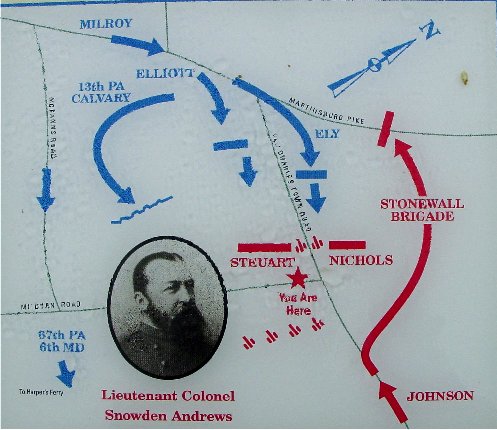Second Winchester Part 3
Stephenson's Depot
| Civil War Trails Map
Ewell had good reason to expect that Milroy would try to escape that
night. The main route north from Winchester went to Martinsburg, the
objective of Rodes's
division. So Ewell sent Edward Johnson's division north from to the only escape route
still open, at Stephenson's
Depot, where the Charlestown Road forked off the Martinsburg Road to Harper's Ferry.
At around 3am on June 15th, the leading
elements of Johnson's division collided with the escaping Yankees where the
Charlestown Road crosses the rail line north from Winchester. The
Confederate infantry took up position in the railroad cut while two
guns, one on the bridge directly over the railroad, supported them. Six more
guns arrived later and took up position on the ridge to the rear. The line
struggled to hold against several attacks, and two attempts were made to
flank the position on the far left.
With the arrival of Walker's Stonewall Brigade, the tide turned, and
many of the Yankees would end up surrendering west of the Martinsburg Road. |
 |

From the Modern Bridge
Johnson's division had approached along the Charlestown Road on
the left, crossed the railroad, and collided with Milroy's escaping Yankees.
The Confederates fell back to the cover of the railroad cut, which was deeper at
the time, and two guns of the 1st Maryland Battery, one of them on the bridge
itself, supported them. Pouring canister into the Union line, which got to
within 40 yards of the guns, the crews lost 13 of 16 men in the fight. The
gun crew on the bridge itself was reduced to just one man.
The six
additional guns were placed on the hill on the left part of the picture, behind
the infantry line,
protecting the left flank. This is the area beyond the road, modern 662,
which you can see entering the Charlestown Road. As the Confederate
defenders were wearing out, and as Milroy was planning attacks on both flanks,
Walker's Stonewall Brigade entered the battle on the far right of the picture
and advanced through the area of the modern lumber yard. The flank attack
broke the will of the Yankees, and many would soon surrender. First,
however, let's look at Milroy's attempts to attack the Confederate left.

13th Pennsylvania Cavalry
The six Confederate guns were located on the hill visible on the
right of the picture, and they had already been vitally important in repulsing
Union attacks. In an effort to eliminate the guns so that the infantry
could push its way through to safety, the 13th Pennsylvania Cavalry of
McReynolds' rear guard brigade moved from the Martinsburg Road across the
railroad, then, I believe, to the hill on the left and center of the photo.
Two of the six Confederate guns fired on the cavalrymen, forcing them back.
The regiment lost 334 of its 655 men in the battle.
Back to
Part 2
Continue to
Part 4


